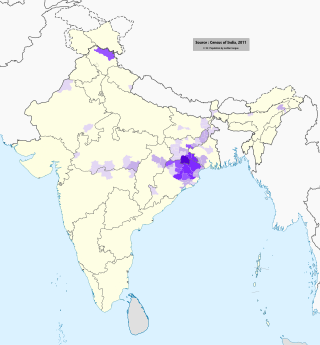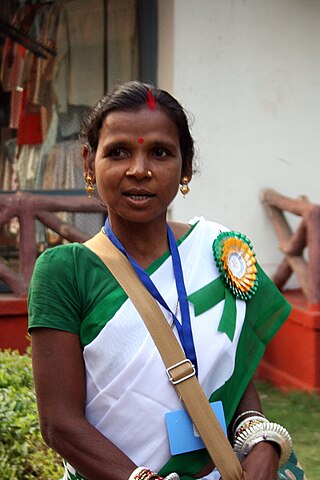Related Research Articles

Ho is a Munda language of the Austroasiatic language family spoken primarily in India by about 2.2 million people per the 2001 census. It is spoken by the Ho, Munda, Kolha and Kol tribal communities of Jharkhand, Odisha, West Bengal and Assam and is written using Warang Citi script. Devanagari, Latin and Odia script are also used, although native speakers are said to prefer Warang Chiti, invented by Lako Bodra.

The Kurukh or Oraon, also spelt Uraon or Dhangad, are a Dravidian speaking ethnolinguistic group inhabiting Chhotanagpur Plateau and adjoining areas - mainly the Indian states of Jharkhand, Odisha, Chhattisgarh, and West Bengal. They predominantly speak Kurukh as their native language, which belongs to the Dravidian language family. In Maharashtra, Oraon people are also known as Dhangad.

The Munda people are an Austroasiatic-speaking ethnic group of the Indian subcontinent. They speak Mundari as their native language, which belongs to the Munda subgroup of Austroasiatic languages. The Munda are found mainly concentrated in the south and East Chhotanagpur Plateau region of Jharkhand, Odisha and West Bengal. The Munda also reside in adjacent areas of Madhya Pradesh as well as in portions of Bangladesh, Nepal, and the state of Tripura. They are one of India's largest scheduled tribes. Munda people in Tripura are also known as Mura.
The tribes of Jharkhand consist of 32 scheduled tribes inhabiting the Jharkhand state in India. In 1872, only 18 tribes were counted among the scheduled tribes from which Banjara, Bhatudi, Chik Baraik, and Mahli were marked as semi-Hindu aboriginal and Kora as proletariat Hindu. In the 1931 census, including the above four semi-Hindu aboriginal and Kora, a proletariat Hindu, the number was raised to 26 from 18. They were Birajia, Godait, Karmali and Paharia, but Kisan was excluded from the list. In the 1941 census, Baga, Bedia and Lohra were included again taking Kisan in the annexure and the number came to 30 which prevailed till June 2003. Kanwar and Kol were added on 8 June 2003 in the annexure and the number of Schedule Tribes came to 32.
Maheshpur is a community development block that forms an administrative division in the Pakur subdivision of the Pakur district, Jharkhand state, India.
Arki block is a CD block that forms an administrative division in the Khunti Sadar subdivision of Khunti district, in the Indian state of Jharkhand.
Karra block is a CD block that forms an administrative division in the Khunti Sadar subdivision of Khunti district, in the Indian state of Jharkhand.
Khunti block is a CD block that forms an administrative division in the Khunti Sadar subdivision of Khunti district, in the Indian state of Jharkhand.
Murhu block is a CD block that forms an administrative division in the Khunti Sadar subdivision of Khunti district, in the Indian state of Jharkhand.
Rania block is a CD block that forms an administrative division in the Khunti Sadar subdivision of Khunti district, in the Indian state of Jharkhand.
Torpa block is a CD block that forms an administrative division in the Khunti Sadar subdivision of Khunti district, in the Indian state of Jharkhand.
The national language and official language of Bangladesh is Bangla according to the third article of the Constitution of Bangladesh. Almost 99% of Bangladeshis speak Bengali as their first language. Bengali Language Implementation Act, 1987 made it mandatory to use Bengali in all government affairs except in the cases of foreign relations. According to a 2022 census, Bengali is predominantly spoken by 99% of the country's population and it also serves as the national language of the nation. The indigenous people of northern and southeastern Bangladesh speak a variety of native languages. According to the Ethnologue, there are 36 indigenous living languages, which include 17 Tibeto-Burman, 10 Indo-Aryan, 7 Austroasiatic and 2 Dravidian languages in Bangladesh. Bangladesh has 44 indigenous languages according to Professor Shameem Reza.

Nagpuri is an Indo-Aryan language spoken in the Indian states of Jharkhand, Chhattisgarh, Odisha and Bihar. It is primarily spoken in the west and central Chota Nagpur plateau region. It is sometimes considered a dialect of Bhojpuri.

The Ho people are an Austroasiatic Munda ethnic group of India. They are mostly concentrated in the Kolhan region of Jharkhand and northern Odisha where they constitute around 10.7% and 7.3% of the total Scheduled Tribe population respectively, as of 2011. With a population of approximately 700,000 in the state in 2001, the Ho are the fourth most numerous Scheduled tribe in Jharkhand after the Santals, Kurukhs, and Mundas. Ho also inhabit adjacent areas in the neighbouring states of Odisha, West Bengal and Bihar bringing the total to 806,921 as of 2001. They also live in Bangladesh and Nepal.
Most of the languages of Bihar, the third most populous state of India, belong to the Bihari subgroup of the Indo-Aryan family. Chief among them are Bhojpuri, spoken in the west of the state, Maithili in the north, Magahi in center around capital Patna and in the south of the state. Maithili has official recognition under the Eighth Schedule to the Constitution of India. The official language of Bihar is Modern Standard Hindi, with Standard Urdu serving as a second official language in 15 districts.
Koda, also known as Kora, Kaora, Korali, Korati, Kore, Mudi, or Mudikora, is an endangered Munda language of India and Bangladesh spoken by the Kora. The Kora mainly live in West Bengal, in the districts of Paschim Medinipur and Bankura, with a few in neighbouring Odisha and Jharkhand. In 2005, there were 1,300 speakers in the Rajshahi Division of Bangladesh, though many said that Bengali was their best language. Koda is closely related to the Kol language.
Purbi Tundi is a community development block that forms an administrative division in Dhanbad Sadar subdivision of Dhanbad district, Jharkhand state, India.
Baghmara is a community development block that forms an administrative division in Dhanbad Sadar subdivision of Dhanbad district, Jharkhand state, India.

Baliapur is a community development block that forms an administrative division in Dhanbad Sadar subdivision of Dhanbad district, Jharkhand state, India.
The Kora, are an ethnic group found in the Indian states of West Bengal, Odisha, Jharkhand, and the Bangladeshi division of Rajshahi. The 2011 census showed their population to be around 260,000. They are classified as a Scheduled Tribe by the Indian government.
References
- ↑ Kol at Ethnologue (18th ed., 2015) (subscription required)
- ↑ "Archived copy" (PDF). Archived from the original (PDF) on 2017-08-09. Retrieved 2014-07-30.
{{cite web}}: CS1 maint: archived copy as title (link)